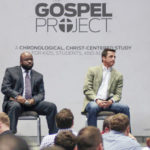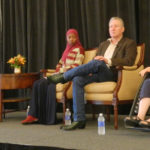June 26, 1966, was one of the most significant times in my life. I was 5 years old growing up in Jackson, Miss. I can remember the day quite vividly, because of the tension in the city, I suppose.
I did not grow up in a Christian home, but I must say my parents made some pretty “Christian” decisions early on in my life that have served as a keel.
 Jeff JohnsonMartin Luther King’s “March Against Fear” began in Memphis, Tenn., June 6, 1966, and reached Jackson on June 26. When the march entered Jackson, it was estimated to be 15,000 strong. Its passage was welcomed warmly in the black neighborhoods and by some whites. However, many whites jeered and threatened the marchers; others simply stayed indoors.
Jeff JohnsonMartin Luther King’s “March Against Fear” began in Memphis, Tenn., June 6, 1966, and reached Jackson on June 26. When the march entered Jackson, it was estimated to be 15,000 strong. Its passage was welcomed warmly in the black neighborhoods and by some whites. However, many whites jeered and threatened the marchers; others simply stayed indoors.
“Warmly welcomed by some whites.” My parents had been pretty radical for a white family with three little boys being raised in Jackson in 1966. I went to the march, a little white boy holding the hand of an African-American friend.
In speech class, I can remember Mrs. Jones introducing me to Dr. King’s prophetic final address, “I’ve Been to the Mountaintop.” He recalled: “I was in New York City autographing the first book that I had written. And while sitting there autographing books, a demented black woman came up. The only question I heard from her was, ‘Are you Martin Luther King?’ And I was looking down writing, and I said yes. And the next minute, I felt something beating on my chest. Before I knew it I had been stabbed by this demented woman. I was rushed to Harlem Hospital. It was a dark Saturday afternoon. And that blade had gone through, and the X-rays revealed that the tip of the blade was on the edge of my aorta, the main artery.  And once that’s punctured, you drown in your own blood; that’s the end of you. It came out in The New York Times the next morning, that if I had sneezed, I would have died.”
And once that’s punctured, you drown in your own blood; that’s the end of you. It came out in The New York Times the next morning, that if I had sneezed, I would have died.”
According to Dr. King’s autobiography, a young girl wrote him a letter. He recounted: “And I looked at that letter, and I will never forget it. It said simply, ‘Dear Dr. King: I am a ninth-grade student at the White Plains High School. … While it should not matter, I would like to mention that I am a white girl. I read in the paper of your misfortune, and of your suffering. And I read that if you had sneezed, you would have died. And I’m simply writing to you to say that I’m so happy that you didn’t sneeze.’”
I am so thankful my parents made cross-cultural and racial diversity a part of the fabric of my rearing. I still am learning and need help with cross-cultural understanding and race relations. It is a temptation to somehow naively, consciously or unconsciously, remove ethnic, cultural and racial realities from my view of life and pretend they don’t exist. Our church faces tremendous multicultural and racial challenges. How about you? Your church? There’s help.
Allow me to introduce my friend Charlie Singleton, who leads our Texas Baptist African-American ministries. He not only leads in linking to ministry and church health resources specific to the African-American churches and other Baptist bodies but enables, equips and educates in understanding cultural diversity for all our churches so we can fulfill the Great Commission of Jesus Christ.
You can contact him at [email protected] or his ministry assistant, Sharron Bradley, at [email protected]. You will be glad you did.
Sign up for our weekly edition and get all our headlines in your inbox on Thursdays
Jeff Johnson is president of the Baptist General Convention of Texas and pastor of First Baptist Church in Commerce.














We seek to connect God’s story and God’s people around the world. To learn more about God’s story, click here.
Send comments and feedback to Eric Black, our editor. For comments to be published, please specify “letter to the editor.” Maximum length for publication is 300 words.